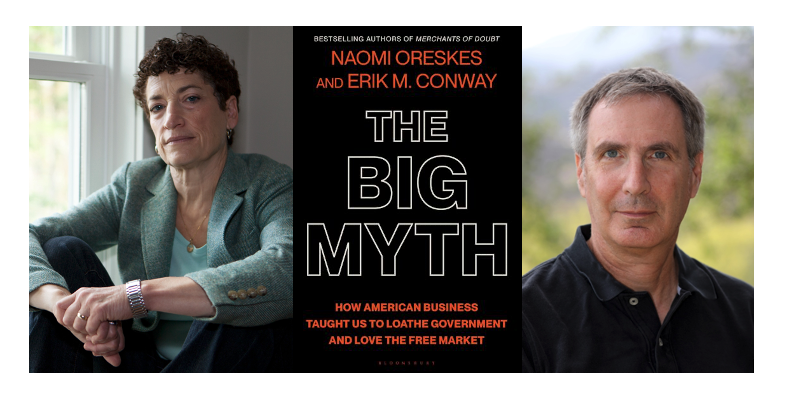Science historians Naomi Oreskes and Erik M. Conway, authors of the classic 2010 book Merchants of Doubt: How a Handful of Scientists Obscured the Truth on Issues from Tobacco Smoke to Global Warming, have released a new book placing that doubt machine into a longer arc of U.S. business and political history.
The Big Myth: How American Business Taught Us to Loathe Government and Love the Free Market explores an even more ambitious history dating from the dawn of the 20th century to the present day.
The book documents how today’s prevailing anti-regulatory and anti-government postures that deride Big Government and cheer for Big Business did not arise simply from grassroots demands. Instead, they arose from well-funded industry campaigns creating what Oreskes and Conway have called a manufactured consensus “quasi-religious belief” in deregulated markets and an accompanying diehard opposition to governmental solutions to public policy problems.
Fighting Public Utilities, Child Labor Laws
One of the first campaigns in that spirit occurred within the electricity utility industry via an organization which eventually became known as the Edison Electric Institute.
What is now colloquially called EEI, was launched in 1885 as the National Electric Light Association, or NELA. At the time, it “represented more than five hundred of the largest privately owned electrical utilities, accounting for more than 90 percent of U.S. kilowatt output,” according to the book.
In the 1920s, according to Oreskes and Conway, “electricity industry leaders organized one of the largest propaganda campaigns in the history of the United States.” The campaign aimed to persuade the public that municipal-owned electricity was a bad thing, advocating instead for investor-owned utilities. In the end, though, it resulted in higher rates for homeowners and small businesses and bigger profits for company owners and their bankrollers.
The initially unpopular campaign framed its activities under the guise of freedom and market efficiency. NELA’s influence operation — involving rewriting K-12 and university textbooks, courting and funding industry-friendly professors, utilizing astroturf campaigns, deploying sophisticated lobbying techniques to facilitate regulatory and legislative capture, and other deceptive practices — resembles much of the fossil fuel industry’s political pressure that DeSmog has covered and uncovered week-in and week-out for over a decade and a half.
At the time, it was the first of its kind industrial-scale full-court press, and it provided a roadmap for other corporate hegemons in subsequent decades. And NELA’s goal went far beyond merely winning a PR campaign, Oreskes and Conway conclude; it had much deeper ideological underpinnings.
“[U]nlike conventional PR, the aim was not simply to create a positive impression of a particular business or even of the whole industry,” they write. “Rather, the goal—expressed outright in numerous documents—was to change the way Americans thought about private property, capitalism, and regulation” altogether.
Core to NELA’s campaign, Oreskes and Conway wrote, was the idea “that free-market capitalism was the embodiment of freedom, writ large, and that any restriction on the freedom of any business would put us on a slippery slope to tyranny.”
Private ownership of the electricity industry was, up until then, relatively rare in the United States and even more so throughout the industrializing world. But as of 2017, 72 percent of U.S. electricity customers got their power from investor-owned utilities. NELA’s campaign, in other words, changed history as we know it.
Today, its successor EEI and its member companies continue to wage deceptive PR campaigns to fight renewable energy and bolster the continued consumption of fossil fuels.
The NELA campaign’s legacy, however, goes far beyond its sector alone, according to Oreskes and Conway. “Perhaps most importantly, NELA pioneered a strategy of insisting that these claims were true, regardless of the facts,” they wrote.
Broadening their view beyond the fossil fuel industry, Oreskes and Conway also detail how the National Association of Manufacturers (NAM) propelled similar efforts across other industries during the same era. Like EEI, fast-forwarding to the present-day, NAM has served as a key node of climate denialism.
But in its earliest days, NAM maintained a different sinister focus, according to The Big Myth: advocating against child labor laws amid what the authors described as a “pandemic” of workplace deaths both among young workers and the adult workforce. The sheer volume of such deaths served as one of the first major wakeup calls in the need for a more active regulatory state, the book maps out.
In making its case for child labor and against regulations protecting children, NAM espoused “that the federal government had no business interfering in business” and called such a notion “socialistic in its origin, philosophy and associations.”
Libertarian Fringe to (Neo)Liberal Mainstream
While both NELA and NAM laid the groundwork for a paradigm that’s alive and well today, their ideas were not adopted globally until the formation of the Mont Pelerin Society, a group created in 1947 that like EEI and NAM has received close scrutiny from DeSmog for years. Oreskes and Conway devote a whole chapter of The Big Myth to Mont Pelerin.
Like NELA and NAM, Mont Pelerin’s roots lay in anti-regulatory and business-funded ideology. But unlike them, Mont Pelerin came out of academia and via professors committed to the now globally pervasive neoliberal ideology they created. Mont Pelerin inspired similar groups that are, like it, still active today, such as the Koch Industries-funded Institute for Humane Studies at George Mason University and the University of Chicago’s free market-oriented Economics Department.
Oreskes and Conway point to a legion of like-minded groups arising by the 1970s, riding the momentum of an academic community devoted to neoliberal ideology, and reacting to the gains made in environmental protection and other areas. Formation of these groups accelerated after the metaphorical call-to-arms made in a memo written to the U.S. Chamber of Commerce by the then-tobacco industry attorney and soon-to-be Supreme Court Justice Lewis Powell.
Known today as the Powell Memo, the 1972 letter called for Big Business to undergo “careful long-range planning and implementation, in consistency of action over an indefinite period of years, in the scale of financing available only through joint effort, and in the political power available only through united action and national organizations.”
The Powell Memo, Oreskes and Conway concluded, spearheaded free market fundamentalist groups such as the Cato Institute, Koch Family Foundations, Scaife Family Foundations, Olin Foundation, Heritage Foundation, and the Federalist Society, among others. All of these entities, and the groups they fund or work alongside in coalitions, remain powerful forces within U.S. and global politics.
The Big Myth further highlights how those think tanks and companies also played a key role in defeating the 2009 and 2010 congressional push, led by then-President Barack Obama, to pass a federal, market-oriented climate bill known as the American Clean Energy and Security Act. Critics would charge that the policy approach taken in the bill, emblematically, embodies the very “market fundamentalist” ethos reigning over U.S. politics for the past 100-plus years.
During the congressional debate over a bill that would have enshrined the policy lever of cap-and-trade, the Koch-funded Tea Party network also ascended.
Previous congressional pushes in the 2000s for what was ultimately a business-friendly climate policy, had enjoyed bipartisan support. But The Big Myth explains how as the Tea Party network took flight, Republican Party support for the climate bill — and broader climate action — eroded to a near-zero level. It has mostly remained there since.
At the same time, the reality of climate change had and has continued to become all the more clear. That reality though, Oreskes and Conway wrote, clashes with the religion of market fundamentalism.
“[H]ad the market fundamentalists spent so much time defending the magic of the market-place that they simply couldn’t accept market failure on a global scale?” the authors asked of the legion of climate-change deniers who helped to kill the bill. “To accept the enormity of what climate change portended for civilization was to accept that capitalism, as practiced, was undermining the very prosperity it was supposed to deliver. And not just in some distant future, but now.”
Although this “quasi-religious belief” in the power of the market holds the greatest sway with conservatives, Oreskes and Conway argue that belief in the “magic of the marketplace” has become an intoxicating ideology within liberal circles too, including within climate policy debates.
“Even in supposedly liberal enclaves like Cambridge, Massachusetts,” where Oreskes teaches at Harvard, “many people think climate change will be best addressed by technological innovation in the marketplace,” the co-authors surmise, perhaps in alluding to the prototypical industry-friendly policies pushed by former Obama Administration U.S. Secretary of Energy Ernest Moniz — a professor at the nearby Massachusetts Institute of Technology.
“The rise of right-wing think tanks helped spread the pro-market, antigovernment gospel across the country and insert what had been decidedly niche views into the mainstream,” the authors explained of the ideology’s spread. Other scholars have referred to this as the “force field” effect, moving the gravitational pull of what’s possible within U.S. politics further and further toward right-wing, corporate-created policy solutions.
The ideological roots of anti-democracy, anti-environmental, and anti-regulatory campaigning explored in The Big Myth also serve as the heart and soul of the book Climate Cover-Up: The Crusade to Deny Global Warming, written by DeSmog co-founders James Hoggan and Richard Littlemore.
If you have learned from DeSmog’s reporting shedding light on the climate change denial machine, you’ll love The Big Myth, an excerpt from which follows below. The book is a must-read for all students of the sordid history of public relations and governmental capture.
Go grab a copy and check out some recent interviews on the book, as well, for further background. A video of Professor Oreskes discussing the book can also be seen below.
Excerpt from The Big Myth
In the 1990s, as capitalism was being declared triumphant in many quarters, scientists had proved that man-made climate change was under way.1“Public Utilities Propaganda in the Schools, June 28, 1928,” Editorial Research Reports 1928,
vol.II,https://library.cqpress.com/cqresearcher/document.php?id=cqresrre1928062800. Climate change was textbook market failure. It arose from everyday economic activity— using fossil fuels—but was about to impose a huge external cost, inundating major coastal cities around the globe, making hurricanes and cyclones even more deadly than they already were, and dislocating tens or even hundreds of millions of people. It was also textbook environmental injustice, as poor people would almost certainly bear the brunt of a problem created by the rich.
But it also had a textbook answer: putting a price on carbon. Economists called this solution a “Pigouvian tax”—after the Cambridge economist Arthur Pigou, who in the early twentieth century had helped develop the concept of negative externalities. (Pigou also suggested it would be reasonable for governments to subsidize activities that had “positive externalities,” such as education.) The idea of pricing social and environmental costs of carbon was hardly radical; Pigou was firmly mainstream, a respected scholar at Cambridge University, a leading figure in what came to be known as the Cambridge school of economics.2Ernest Gruening, The Public Pays: A Study of Power Propaganda (New York: Vanguard Press, 1931), 107. The obvious benefit of the Pigouvian approach was that it remedied the market failure directly by embedding information—in this case scientific information—into the price of fossil fuels. Then consumers could decide for themselves whether or not to buy more expensive fossil fuels, and producers of alternatives could compete on a level playing field.
The Clinton administration proposed to address climate change through a Pigouvian tax, the so-called “BTU” tax (referring to the heat content of fuels as measured in British Thermal Units).3Ibid., 106. But it was opposed—indeed, ridiculed—by a broad coalition of conservatives, including, the Chamber of Commerce, the American Petroleum Institute, and virtually every right-wing think tank in America.4“Public Utilities Propaganda.” The notorious Global Climate Coalition, a network of fossil fuel producers and users that in the 1990s successfully prevented the U.S. Congress from ratifying the Kyoto protocol to the U.N. Framework Convention on Climate Change, was originally established as a committee of the National Association of Manufacturers. Even though the idea of putting a price on carbon was a mainstream economic approach to market failure, Republicans framed it as just another example of Democrats’ penchant to “tax and spend.” The Wall Street Journal mocked it as Al Gore’s “favorite tax.”5Ibid.
In his 1979 paper on nonmarket failure, economist Charles Wolf had slipped into his conclusion the idea that one cause of nonmarket failure was “premature but politically effective demands for government action.”6Ibid. In the 1990s, many Republicans picked up on this theme, arguing that it was premature to act on climate change. Even at the time, that was wrong: scientists already had a consensus that man-made climate change was under way and likely to be very costly.7Ibid., 26–27. Gruening, The Public Pays, 117. To act in the 1990s would have been appropriate. It would have been timely. But Clinton was unable to generate congressional support for action; Republican opposition made it clear that any proposal to put a price on carbon would be dead on arrival. In 1999, when Vice President Al Gore ran for president on a platform prioritizing climate change, journalist Gregg Easterbrook (brother of Judge Frank Easterbrook) embarrassed him on the campaign trail with a false story that his mentor—climate champion Roger Revelle—had experienced a deathbed conversion and died thinking climate change was not a serious problem.8“Letter from the Chairman of the Federal Trade Commission in Response to Senate
Resolutions Nos. 83 and 112, Exhibit 1432 to 2575,” 70th Congress, 1st session (Washington,
D.C.: U.S. Government Printing Office, 1930), 797. (He had not.)
As the 1990s became the 2000s—and scientists declared the evidence “unequivocal”—market fundamentalist did not adjust their views. To the contrary, their opposition hardened.9NELA, “Proceedings of the 49th Convention,” 1926, 310, folder 12, box 15, Clyde Orval
Ruggles Papers, HBS Archives, Baker Library Historical Collections, Harvard Business School. The speaker here is the chairman of the Committee on Cooperation with Educational Institutions. He was giving remarks to the 1926 NELA convention.
In 2006, Lord Nicholas Stern, former chief economist of the World Bank, concluded on behalf of the UK government that, yes, fixing climate change would be expensive—perhaps as much as 1 percent of global GDP per annum—but not fixing it would cost much more: at least 5 percent and perhaps as much as 20 percent.10Quoted in “Public Utilities Propaganda.” Here was a solid argument from a man who could scarcely be accused of being any kind of -ist other than an economist. In response, conservatives dug in deeper. Senator Ted Cruz promoted the canard that global warming had stopped; Senator James Inhofe called it a liberal conspiracy to bring down capi- talism.11Gruening, The Public Pays, 64. No matter what solutions were proposed—market-friendly or not—the right wing found reasons to oppose them. The science wasn’t settled (they claimed). It would be too expensive to fix. We could just adapt. It was all a hoax. Often these claims were couched in libertarian terms, as when in 2011 former House Speaker Newt Gingrich deemed the push to address climate change “the newest excuse to take control of lives.”12Ibid., 145.
The singular exception to climate denial in Republican Party leadership was Senator John McCain. He and conservative Democrat Joe Lieberman introduced Climate Stewardship acts in 2003, 2005, and 2007 to address the carbon dioxide emissions that drive climate change by creating an emissions trading system—a proven mechanism, albeit more complicated than a Pigouvian tax. But when given the chance to use it to address climate change, Republicans refused.13Ibid., 223–24. The 2003 bill failed on mostly party lines, with a few Democrats and nearly all Republicans in opposition. But it was a closer call than many expected, and soon Congress faced intense lobbying pressure against climate legislation, particularly from NAM and the U.S. Chamber of Commerce. The 2005 version came to a vote and failed 60–38, with only a handful of Republicans voting yea.14Ibid., 69; “Public Utilities Propaganda.” Two years after that, McCain could not even persuade Republican leaders to bring a climate bill to the Senate floor.15Groening, The Public Pays, 63.
In 2009, Congress tried once more, with the American Clean Energy and Security Act (better known as Waxman-Markey, for its primary sponsors, Massachusetts representative Ed Markey and California representative Henry Waxman). For the fourth time in a decade, Congress had the opportunity to address climate change using a market mechanism, and for the fourth time rejected it. The bill barely passed the Democratic-led House; nearly all Republicans voted against, as did Democrats from fossil-fuel-producing states (and a few Democrats who found the bill too weak). The Senate never brought it to a vote. Democrats concluded they could not overcome the “wall of opposition” they faced from their Republican colleagues, opposition fortified by fierce lobbying.16Wendy L. Wall, Inventing the “American Way”: The Politics of Consensus from the New Deal to
the Civil Rights Movement (Oxford: Oxford University Press, 2008); see also Jean Christie, Morris Llewellyn Cooke: Progressive Engineer (New York: Garland Publishing, 1983), 53. One analysis concluded that, in the eighteen months between January 2009 and June 2010, electric utilities, oil and gas companies, trade associations, and think tanks spent at least $500 million against climate change legislation.17“Letter from the Chairman of the Federal Trade Commission,” 380. Another study tracing anti-climate lobbying back to 2003 places the figure at closer to $1 billion.18Gruening, The Public Pays, 40.
The fossil fuel industry’s economic interests in preventing climate action have always been obvious; less understood is how it has camouflaged those interests. No one ever said, “I am denying climate change to protect corporate profits.” They said they were protecting jobs, protecting the economy, and protecting free markets from government “encroachment.” They said they were fighting for capitalism and freedom.
But historically, capitalism has never been just one thing: Adam Smith’s eighteenth-century vision of a democratic, distributed marketplace populated by small bankers and businessmen was a far cry from the industrial capitalism that developed in early nineteenth-century England and Germany—with its cruel “Satanic mills”—or the monopolies and managerial capitalism that came to dominate America in the late nineteenth century, much less the globally financed capitalism that emerged at the end of the twentieth century. China has liberalized its markets while continuing to oppress and even murder its ethnic and religious minorities. There are many capitalisms. American market fundamentalists fight for a form of capitalism that is both brutal and ignorant: that brushes aside market failure, anticompetitive practices, and external costs, in part by denying the facts of science, the facts of history, and the necessary role of government in making capitalism work.19“Letter from the Chairman . . . Exhibits 1435 to 2575,” 379.
The question is not whether government should set limits that prevent individual autonomy from producing collective harm, the question is where we draw the lines. That is not an economic question, it is a political one. Market fundamentalists have managed to distract from the political aspects of these decisions and frame them as questions of “economic freedom.” Thus, a reasonable response to climate change is rejected as unreasonable “government encroachment.”
All this may make one wonder: was this ever really about capitalism? Or freedom? Or was it all just one long, semi-continuous, shape-shifting defense of the prerogatives of big business? Of freedom for capital and capitalists? Or had the market fundamentalists spent so much time defending the magic of the market- place that they simply couldn’t accept market failure on a global scale? To accept the enormity of what climate change portended for civilization was to accept that capitalism, as practiced, was undermining the very prosperity it was supposed to deliver. And not just in some distant future, but now.
- 1“Public Utilities Propaganda in the Schools, June 28, 1928,” Editorial Research Reports 1928,
vol.II,https://library.cqpress.com/cqresearcher/document.php?id=cqresrre1928062800. - 2Ernest Gruening, The Public Pays: A Study of Power Propaganda (New York: Vanguard Press, 1931), 107.
- 3Ibid., 106.
- 4“Public Utilities Propaganda.”
- 5Ibid.
- 6Ibid.
- 7Ibid., 26–27. Gruening, The Public Pays, 117.
- 8“Letter from the Chairman of the Federal Trade Commission in Response to Senate
Resolutions Nos. 83 and 112, Exhibit 1432 to 2575,” 70th Congress, 1st session (Washington,
D.C.: U.S. Government Printing Office, 1930), 797. - 9NELA, “Proceedings of the 49th Convention,” 1926, 310, folder 12, box 15, Clyde Orval
Ruggles Papers, HBS Archives, Baker Library Historical Collections, Harvard Business School. The speaker here is the chairman of the Committee on Cooperation with Educational Institutions. He was giving remarks to the 1926 NELA convention. - 10Quoted in “Public Utilities Propaganda.”
- 11Gruening, The Public Pays, 64.
- 12Ibid., 145.
- 13Ibid., 223–24.
- 14Ibid., 69; “Public Utilities Propaganda.”
- 15Groening, The Public Pays, 63.
- 16Wendy L. Wall, Inventing the “American Way”: The Politics of Consensus from the New Deal to
the Civil Rights Movement (Oxford: Oxford University Press, 2008); see also Jean Christie, Morris Llewellyn Cooke: Progressive Engineer (New York: Garland Publishing, 1983), 53. - 17“Letter from the Chairman of the Federal Trade Commission,” 380.
- 18Gruening, The Public Pays, 40.
- 19“Letter from the Chairman . . . Exhibits 1435 to 2575,” 379.
- 1“Public Utilities Propaganda in the Schools, June 28, 1928,” Editorial Research Reports 1928,
vol.II,https://library.cqpress.com/cqresearcher/document.php?id=cqresrre1928062800. - 2Ernest Gruening, The Public Pays: A Study of Power Propaganda (New York: Vanguard Press, 1931), 107.
- 3Ibid., 106.
- 4“Public Utilities Propaganda.”
- 5Ibid.
- 6Ibid.
- 7Ibid., 26–27. Gruening, The Public Pays, 117.
- 8“Letter from the Chairman of the Federal Trade Commission in Response to Senate
Resolutions Nos. 83 and 112, Exhibit 1432 to 2575,” 70th Congress, 1st session (Washington,
D.C.: U.S. Government Printing Office, 1930), 797. - 9NELA, “Proceedings of the 49th Convention,” 1926, 310, folder 12, box 15, Clyde Orval
Ruggles Papers, HBS Archives, Baker Library Historical Collections, Harvard Business School. The speaker here is the chairman of the Committee on Cooperation with Educational Institutions. He was giving remarks to the 1926 NELA convention. - 10Quoted in “Public Utilities Propaganda.”
- 11Gruening, The Public Pays, 64.
- 12Ibid., 145.
- 13Ibid., 223–24.
- 14Ibid., 69; “Public Utilities Propaganda.”
- 15Groening, The Public Pays, 63.
- 16Wendy L. Wall, Inventing the “American Way”: The Politics of Consensus from the New Deal to
the Civil Rights Movement (Oxford: Oxford University Press, 2008); see also Jean Christie, Morris Llewellyn Cooke: Progressive Engineer (New York: Garland Publishing, 1983), 53. - 17“Letter from the Chairman of the Federal Trade Commission,” 380.
- 18Gruening, The Public Pays, 40.
- 19“Letter from the Chairman . . . Exhibits 1435 to 2575,” 379.
Subscribe to our newsletter
Stay up to date with DeSmog news and alerts







